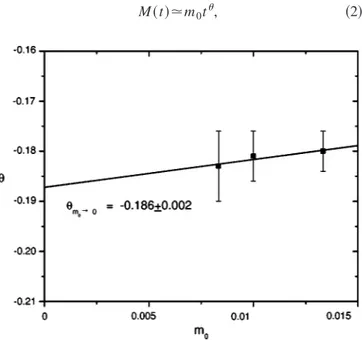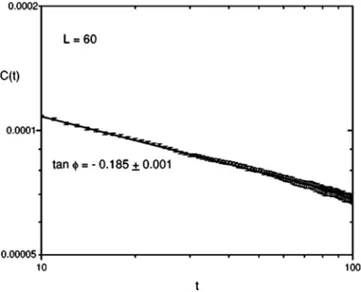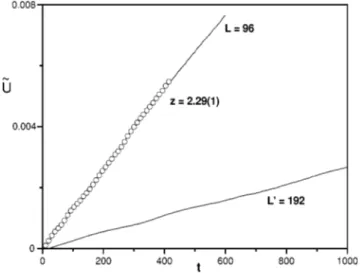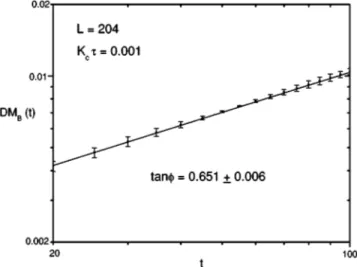Short-time critical dynamics of the Baxter-Wu model
Everaldo Arashiro*and J. R. Drugowich de Felı´cio†
Departamento de Fı´sica e Matema´tica, Faculdade de Filosofia, Cieˆncias e Letras de Ribeira˜o Preto, Universidade de Sa˜o Paulo, Avenida Bandeirantes, 3900-CEP—14040-901, Ribeira˜o Preto, Sa˜o Paulo, Brazil
~Received 22 November 2002; published 29 April 2003!
We study the early time behavior of the Baxter-Wu model, an Ising model with three-spin interactions on a triangular lattice. Our estimates for the dynamic exponentzare compatible with results recently obtained for two models which belong to the same universality class of the Baxter-Wu model: the two-dimensional four-state Potts model and the Ising model with three-spin interactions in one direction. However, our estimates for the dynamic exponentuof the Baxter-Wu model are completely different from the values obtained for those models. This discrepancy could be related to the absence of a marginal operator in the Baxter-Wu model.
DOI: 10.1103/PhysRevE.67.046123 PACS number~s!: 64.60.Ht, 75.10.Hk, 02.70.Uu
I. INTRODUCTION
Since the work of Janssenet al.@1#and Huse@2#point out that universality and scaling are present at the early stage of the time evolution of dynamic systems, several statistical models have been investigated using the Monte Carlo simu-lations in the short-time regime @3#. This kind of investiga-tion avoids the critical slowing down effects and provides an alternate method for calculating the dynamic exponentz, the static exponents b andn as well as the new dynamic expo-nentu that governs the anomalous behavior of the nonequi-librium magnetization when the system is quenched to the critical temperature Tc. Using this different approach the
kinetic Ising and Potts models @4 – 8#were exaustively stud-ied in order to confirm available results and to enlarge our knowledge of critical phenomena, including the critical re-laxation of the early time dynamics.
In this paper, we revisit the Ising model with three-spin interactions on a triangular lattice, called Baxter-Wu ~BW! model after its exact solution obtained 30 years ago@9#. The motivation arises from the disagreement between results for the exponentzobtained for the BW model and for two other models—the two-dimensional four-state Potts model and the Ising model with three-spin interactions in one direction— which are known to belong to the same universality class. The BW model consists of Ising spins (Si561) on a trian-gular lattice with the Hamiltonian
H52J
(
^i,j,k& SiSjSk, ~1!
where the sum involves the product of the spins on each triangle of the lattice. As the Ising model on a square lattice this model undergoes a phase transition at the critical tem-perature Kc5J/kTc50.5 ln(11
A2). The ground state is
fourfold degenerate~see Fig. 1!and the relevant symmetry is semiglobal~the Hamiltonian is invariant under reversal of all of the spins belonging to two of three sublatices into which the original lattice can be decomposed!. The BW model
ex-hibits the same static critical exponents (a5n52/3 and h
51/4) @10#as those of the two-dimensional four-state Potts model and of the Ising model with three-spin interactions ~IMTSI!in one direction@11#. However, finite-size studies of the BW model have good convergence, without running into the known difficulties encountered in the studies of these other models. Several authors @12#have attributed that dif-ference to a dangerous marginal operator present in the four-state Potts and IMTSI models which does not have a coun-terpart in the BW model.
Although the static critical behavior of these systems is well understood, only a few results are known regarding dy-namical properties. For instance, much work it is needed to unravel the interesting question of a possible extended uni-versality, i.e., if these three models~BW, four-state Potts, and the IMTSI!exhibit the same exponentz. Previous estimates of the critical exponent z for the four-state Potts model are scattered between 2 and 4@13#. The most recent results, how-ever, suggest values close to 2.3 @14,15#. Short-time simula-tions for the BW model were first performed by Santos and Figueiredo @16#, who foundz52.07(1), a very small value when compared to the values obtained for the same expo-nents of the four-state Potts and IMTSI models @14,15#. Moreover, they stress that this value ofzis very close to the dynamic exponent of the the two-dimensional ~2D! Ising model when a Glauber dynamics is used @17#. For the new dynamic exponent u related to the critical initial slip of the order parameter, situation is even worse. Okano et al.have conjectured@4#that for the four-state Potts model the expo-nentu should be negative and close to zero. This result was only recently confirmed @18#. For the IMTSI model, two in-dependent estimates were obtained @15,19# and fall in the range20.04,u,0.07, whereas estimates for the BW model are not available.
Motivated by our recent results for the IMTSI model@15#, we decided to investigate the short-time critical dynamics of the BW model in order to check the value of the dynamic exponentzand the utility of the exponentu in detecting the presence of a marginal operator @5,6,20#. In the following section we calculate the exponentustudying the evolution of the order parameter for different values of the initial sublat-tice magnetization m05(3/N)(iSi(0), where the index i
runs over only one kind of sites of the triangular lattice *Email address: everaldo@dfm.ffclrp.usp.br
†Email address: drugo@usp.br
~circle, square or star points in Fig. 1!andNis the number of spins. In addition, we estimate the same exponent calculating the time correlation of the order parameter @21#. In Sec. III we summarize our results for the dynamic critical exponent z. In Sec. IV we list estimates for the correlation length ex-ponentnand for the indexbof the magnetization. Finally, in section V we present our conclusions.
II. THE DYNAMIC EXPONENTu
Janssen et al.@1# have shown on the basis of the renor-malization group theory that, at an early stage of the time evolution, quantities such as the magnetization and its mo-ments follow a power law when the parameters of a dynami-cal system are adjusted to their critidynami-cal values. The exponent
u that characterizes the time evolution of the magnetization is independent of the known set of static critical exponents and even from the dynamic exponentz. However, like other exponentsu seems to depend on general properties such as dimensionality of the spin and either symmetry of the Hamil-tonian or the evolution rules. Such universal behavior was
found in two- and three-dimensional Ising models @4,22#, two-dimensional three- and four-state Potts models @14,23# as well as in irreversible models with synchronous and con-tinuous dynamics @21,24,25#. In addition, nonuniversal be-havior was detected for the exponent u @5,6,26,27#although always accompanied by a marginal operator.
In this paper we estimate the dynamic exponentu by two different techniques. First we quench the system from a high temperature to Tc and follow the nonequilibrium relaxation
of various realizations of the process with the same initial sublattice magnetizationm0. In Fig. 2 we show the behavior of the order parameter whenm050.01. As proposed by Jan-ssenet al.@1#it follows the power law
M~t!.m0tu, ~2! FIG. 1. The Baxter-Wu model is defined on a triangular lattice
where the Ising spins (Si561) are coupled by nearest neighbor three-spin interactions. The lattice can be divided into three sublat-tices, characterized in the figure by circles, squares, and stars. Each symbol represents a class of spins which does not interact with each other. The ground state is fourfold degenerate, corresponding to the three configurations with up spins in two sublattices and down spins in the other, besides the obvious configuration of spins up in all the sublattices.
FIG. 2. Power law behavior of the magnetization for samples with initial magnetizationm050.01. The error bars were calculated over 10 sets of 60 000 samples.
FIG. 3. Dynamic exponentuas a function of the initial magne-tization m0 for the lattice size L560. Each point represents an
but hereu is negative. Figure 3 exhibits the behavior of the exponentu for different values ofm0, as well as a linear fit that leads to the value u520.18660.002.
The second technique consists of studying the time corre-lation of the magnetization
C~t!5
K
(
iSi~t!
(
jSj~0!
L
, ~3!which was shown@21#to behave astuwhen
^
M(0)&
50. In Fig. 4 we show the time dependence of the time correlation C. We stress that this approach was shown to be valid when the evolution matrix has up-down symmetry which is not valid in the present case. However, it is possible to show@28# that the Z(2)^Z(2) symmetry of the BW Hamiltonian is sufficient to preserve the above mentioned result. The value of u obtained with this technique (u520.18560.001) cor-roborates the value obtained directly from the behavior of the magnetization. We stress that the time correlation method @21#is numerically more convenient, since we do not need to work with specially prepared initial configurations ~with fixed m0) nor it is necessary to take the delicate limit m0 →0.The results obtained with the two techniques are essen-tialy the same and fall in the range 20.188<u<20.184. They are completely different from the value u520.03
60.01 encountered for the IMTSI model @15# and from u
520.04760.0033 @18# obtained recently for the four-state Potts model. Thus, based on our estimates for the exponentu
of the BW model, we conclude that its dynamic behavior at short time is completely different from that of the IMTSI and four-state Potts models albeit both models have the same static exponents as the BW model. Thus, at least in this case, the exponentu seems to be able to capture the subtle differ-ence between models that have the same leading exponents but not the same corrections to scaling.
III. THE DYNAMIC CRITICAL EXPONENTz
Santos and Figueiredo@16#obtained the exponentzof the BW model by means of the second-order cumulantU2 @8#,
U25
^
M2
&
^
M&
221, ~4!starting from completely ordered samples (m051). As claimed by Zheng,U2 should behave at the critical tempera-ture as a power law
U2}td/z, ~5!
which would allow us to estimatezwithout using any other critical exponents. Santos and Figueiredo found z52.07(1) form051 ~all sublattices initially with spins up!and 1.96(2) for m0521/3, i.e., spins are initially up in one sublattice and down in the other two. These estimates, obtained with Glauber dynamics @17#, are very different from results re-cently obtained for the four-state Potts model@14#and for the Ising model with three-spin interactions in one direction@15# which both yield values close to 2.3.
This kind of disagreement has already appeared in the literature when the second cumulant was used to obtain es-timates for the exponentzfor the three-state Potts model@8# and the IMTSI model@15#. Thus, in order to check if the BW model~which also belongs to the four-state Potts model uni-versality class!exhibits indeed a different value for the dy-namic exponent z, we have calculated this exponent using three other techniques. To begin with, we estimated z by collapsing the generalized fourth-order Binder cumulant
U4~t,t,L!512
^
M4
&
3^M2
&
2, ~6!which should only depend on the ratio t/Lz when T5Tc,
according to scaling laws valid in the beginning of the evo-lution. In Fig. 5 we show the Binder cumulant as a function of the time for two different lattices L596 and L
8
5192, both starting from ordered states (m051). We also plot in Fig. 5 the cumulant for the larger lattice against the rescaled timet8
52zt, where zis defined via the relationU4~2zt,0,L
8
!5U4~t,0,L!. ~7! After interpolating the rescaled curve for the lattice L8
, the value of zis selected using thex2 test@29#yielding the best estimate 2.285(10). We applied the same analysis to the cumulant@8#U ˜5
^
M2
&
uMu221, ~8!
using (m051) as shown in Fig. 6. The result in this case is z52.29(1).
Finally, we used mixed initial conditions in order to ob-tain the functionF2(t), given by
FIG. 4. Time correlation of the total magnetization for samples with ^M(t50)&50. Error bars were calculated over 10 sets of 60 000 samples.
F2~t!5
^
M2&
m050^
M&
m0512 , ~9!
which was shown@14#to behave astd/z. This approach was recently proposed in order to obtain the exponentzwith high precision. Actually, curves of F2 are straight lines~see Fig. 7!which do not depend on the lattice size~one does not need to rescale the time!. Our estimate for z using Eq. ~9! and taking values at each 5 steps isz52.294(6). This value is in complete agreement with the resultz52.290(3) recently ob-tained @14# for the four-state Potts model and corroborates the above results obtained by different procedures.
It is worth stressing that all the results shown until now were obtained with heat-bath updating, whereas Santos and Figueiredo@16#performed simulations using the Glauber dy-namics. In order to rule out any influence of the dynamics on
the results we repeated our simulations using the Glauber updating and verified that our result remain essentially the same. In addition, we have used heat-bath updating to calcu-late the time dependence of the second-order cumulant@Eq. ~4!#where the average is always obtained from initially or-dered samples (m051). Our best estimate for z is 2.03
60.01, which agrees reasonably well with the result by San-tos and Figueiredo, indicating that this severe disagreement stems from a difficulty from the scaling for the second cu-mulant method.
IV. THE THERMAL EXPONENTSn ANDb
Taking the logarithmic derivative of the magnetization@8#
M~t,t!5t2b/nzM~1,t1/nzt! ~10!
with respect tot5(T2Tc)/Tc, we obtain
]tlnM~t,t!5t1/nz]t8ln~F~t
8
!ut850, ~11! which follows a power law that does not depend onL, where F(t8
) is a scaling function. Thus, a log-log plot of that de-rivative versus time gives 1/nz ~see Fig. 8!. Once we have obtained the dynamical exponent z, the thermal exponent nmay be determined. Our estimate for the exponent n in the short-time analysis is 0.6560.01 which should be compared to the exact value 2/3 from Ref. @30#.
Next, we follow the decay of the sublattice magnetization in initially ordered samples (m051). The scaling law
M}t2b/nz ~12!
allows us to obtainb/nzwhich in turn leads to the exponent
b by using the previous result for the productnz. We show a log-log plot of M versus tin Fig. 9. A linear fit gives the value 0.052760.0005 for the ratiob/nz leading to the esti-mate
FIG. 5. Binder cumulant U4(t,0,L) for lattice sizeL596 and
L85192 and initial magnetizationm051. The open circles on the continuous line show the cumulant for the bigger lattice rescaled in time withzobtained from Eq.~7!.
FIG. 6. U˜ cumulant forL596, L85192 and initial magnetiza-tionm051. The open circles correspond to the rescaled cumulant
for the larger lattice withz52.29(1).
FIG. 7. Time evolution of F2 for L5102 with mixed initial
b50.07960.002. ~13!
We stress that our result forb is in fair agreement with the exact result 1/12 @9#.
Before closing this section we present another estimate for the exponents b andn obtained from scaling of the so-called Baxter order parameter MB given by
MB5
(
^i j k&
SiSjSk, ~14!
where the sum is done over all triangles of the lattice and the indices i,j, andkdenote sites composing an elementary tri-angle ~plaquette!. Barber and Baxter @31# have shown that MB is zero for temperatures below Tc and different from
zero above Tc. In this sense MB functions as a disorder
parameter@32#which goes to zero whenT→Tcfrom above. However, this new quantity has the same critical exponent as the sublattice magnetization. Thus, the exponent b can be obtained following the evolution of Baxter’s order parameter. The advantage is that we do not need to divide the system into sublattices. In Fig. 10 we show the decay of the Baxter order parameter as well as the value of the ratio b/nz. In order to eliminate the product nz from our result we start again from ordered samples (MB51) and use Eq. ~11!
re-placing M byMB to obtain 1/nz. Figure 11 shows the
evo-lution of the derivative. Our new estimate for 1/nz is 0.651
60.006, yelding for n the value 0.6760.01 in very good agreement with the exact result 2/3@9#. The new estimate for
b is 0.08060.002 which is in fair agreement with our pre-vious result and should be compared to the pertinent result 1/12.
FIG. 8. Logarithmic derivative of the magnetization with respect to the reduced temperatureD M(t) as a function of time. Data were obtained for the lattice size L5102 using temperature variation
Kct50.001. The slope corresponds to the ratio 1/nz, after Eq.~11!. The error bars, calculated over 10 sets of 30 000 samples, are smaller than the size of the points.
FIG. 9. Log-log plot of the time evolution of the magnetization for initially ordered samples (m051). The error bars ~calculated
over 5 sets of 1000 samples!are smaller than the size of the points.
FIG. 10. Time decay of Baxter’s order parameter MB. Error bars were calculated over 5 sets of 10 000 samples.
FIG. 11. Logarithmic derivative of Baxter’s order parameter
MB. Data were obtained for the lattice sizeL5204 using tempera-ture variation Kct50.001. Five sets of 10 000 initially ordered samples (m051) were used in order to obtain the error bars.
V. CONCLUSIONS
We revisited the Baxter-Wu model using the short-time Monte Carlo simulations. Our best estimate for the dynamic critical exponent is z52.29460.006. It was obtained by a recently proposed technique @14# that combines simulations performed with different initial conditions. This result is compatible with recently obtained estimates forzin the case of the two-dimensional four-state Potts model@14#as well as for the two-dimensional Ising model with three-spin interac-tions along one direction@15#. The result forzwas confirmed by two other techniques based on the collapse of cumulants. In addition, using scaling relations for the order parameter and its derivative with respect to the reduced temperaturet, we were also able to estimate the static critical exponentsb
andn. We have also obtained the exponentsb andn using Baxter’s order parameter. The results for these exponents are in good agreement with the exact values @9#. However, our
estimates for the new dynamic exponentu of the Baxter-Wu model are completely different from the values found for that index when studying the two-dimensional Ising model with three-spin interactions in one direction and the four-state Potts model. In this sense, the exponentuseems to be able to capture subtle difference between models which exhibit the same leading critical exponents but different corrections to scaling.
ACKNOWLEDGMENTS
We would like to thank T. Tome for discussions about her result concerning the validity of the correlation method for the BW model prior to its publication. We would also like to thank R. Dickman, N. Caticha, N. Alves, U. H. E. Hans-mann, and N. Alves, Jr. for discussions and a careful reading of the manuscript. This work was supported by the Brazilian agencies FAPESP, CAPES and CNPq.
@1#H.K. Janssen, B. Schaub, and B. Schmittmann, Z. Phys. B: Condens. Matter73, 539~1989!.
@2#D.A. Huse, Phys. Rev. B40, 304~1989!.
@3#Z.B. Li, L. Schu¨lke, and B. Zheng, Phys. Rev. Lett.74, 3396 ~1994!.
@4#K. Okano, L. Schu¨lke, K. Yamagashi, and B. Zheng, Nucl. Phys. B485, 727~1997!.
@5#C.S. Simo˜es and J.R. Drugowich de Felı´cio, J. Phys. A31, 7265~1998!.
@6#A.J. Ye, Z.G. Pan, Y. Chen, and Z.B. Li, Commun. Theor. Phys. 33, 205 ~2000!; N. Alves, Jr. and J.R. Drugowich de Felı´cio, Mod. Phys. Lett. B~to be published!.
@7#R. da Silva, N.A. Alves, and J.R. Drugowich de Felı´cio, Phys. Rev. E66, 026130~2002!.
@8#B. Zheng, Int. J. Mod. Phys. B12, 1419~1998!.
@9#R.J. Baxter and F.Y. Wu, Phys. Rev. Lett.31, 1294~1973!. @10#F.Y. Wu, Rev. Mod. Phys.54, 235~1982!.
@11#J.M. Debierre and L. Turban, J. Phys. A16, 3571~1983!. @12#F.C. Alcaraz and J.C. Xavier, J. Phys. A30, L203~1997!;32,
2041~1999!.
@13#L. Arcangelis and N. Jan, J. Phys. A19, L1179~1986!. @14#R. da Silva, N.A. Alves, and J.R. Drugowich de Felı´cio, Phys.
Lett. A298, 325~2002!.
@15#C.S. Simo˜es and J.R. Drugowich de Felı´cio, Mod. Phys. Lett. B15, 487~2001!.
@16#M. Santos and W. Figueiredo, Phys. Rev. E63, 042101~2001!. @17#R.J. Glauber, J. Math. Phys.4, 294~1963!.
@18#R. da Silva and J.R. Drugowich de Felı´cio~unpublished!. @19#L. Wang, J.B. Zhang, H.p. Ying, and D.R. Ji, Mod. Phys. Lett.
B13, 1011~1999!.
@20#K. Oerding and H.K. Janssen, J. Phys. A26, 3369~1993!. @21#T. Tome´ and M.J. de Oliveira, Phys. Rev. E58, 4242~1998!. @22#M. Silve´rio Soares, J.K. da Silva, and F.C. SaBarreto, Phys.
Rev. B55, 1021~1997!.
@23#L. Schulke and B. Zheng, Phys. Lett. A204, 295~1995!. @24#J.F.F. Mendes and M.A. Santos, Phys. Rev. E57, 108~1998!. @25#T. Tome´ and J.R. Drugowich de Felı´cio, Mod. Phys. Lett. B 12, 873 ~1998!; A. Brunstein and T. Tome´, ibid. 13, 471 ~1999!.
@26#Z.B. Li, X.W. Liu, L. Schulke, and B. Zheng, Physica A245, 485~1997!
@27#T. Tome, C.S. Simo˜es, and J.R. Drugowich de Felı´cio, Mod. Phys. Lett. B15, 1141~2001!.
@28#T. Tome, e-print cond-mat/0304218.
@29#W. Press et al., Numerical Recipes ~Cambridge University Press, London, 1986!.
@30#R.J. Baxter, Exactly Solved Models in Statistical Mechanics ~Academic Press, London, 1982!.



